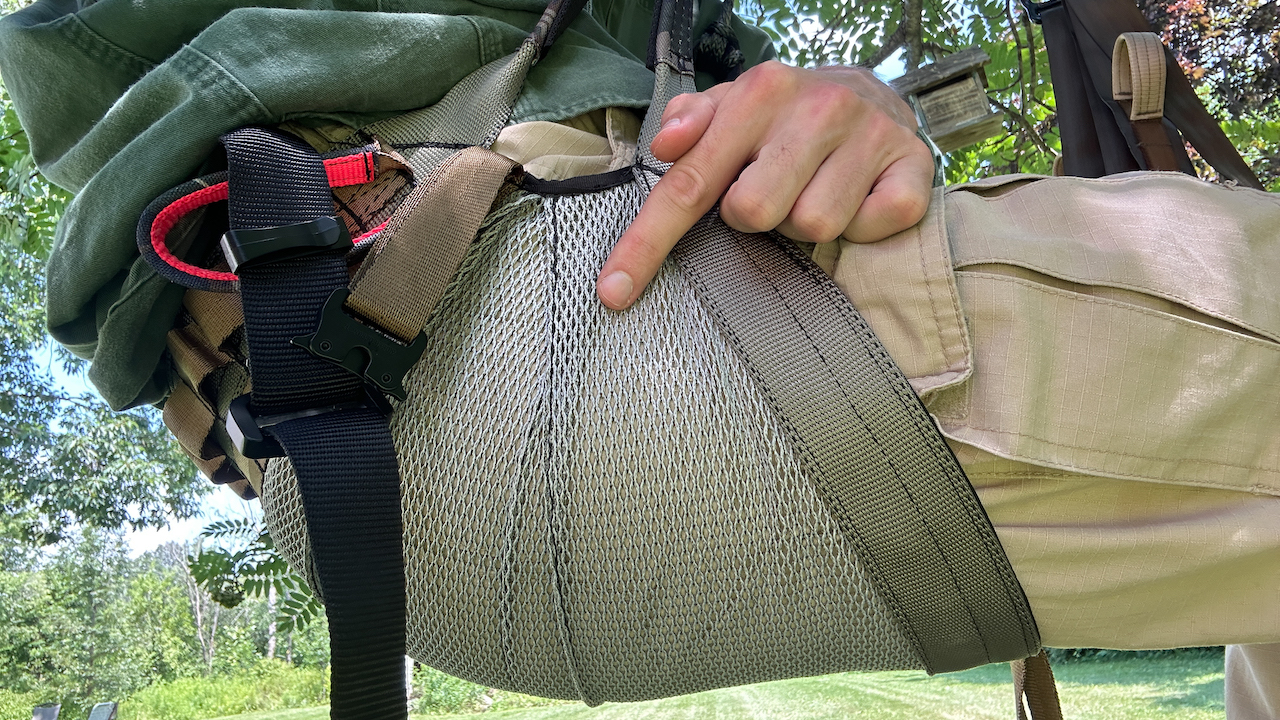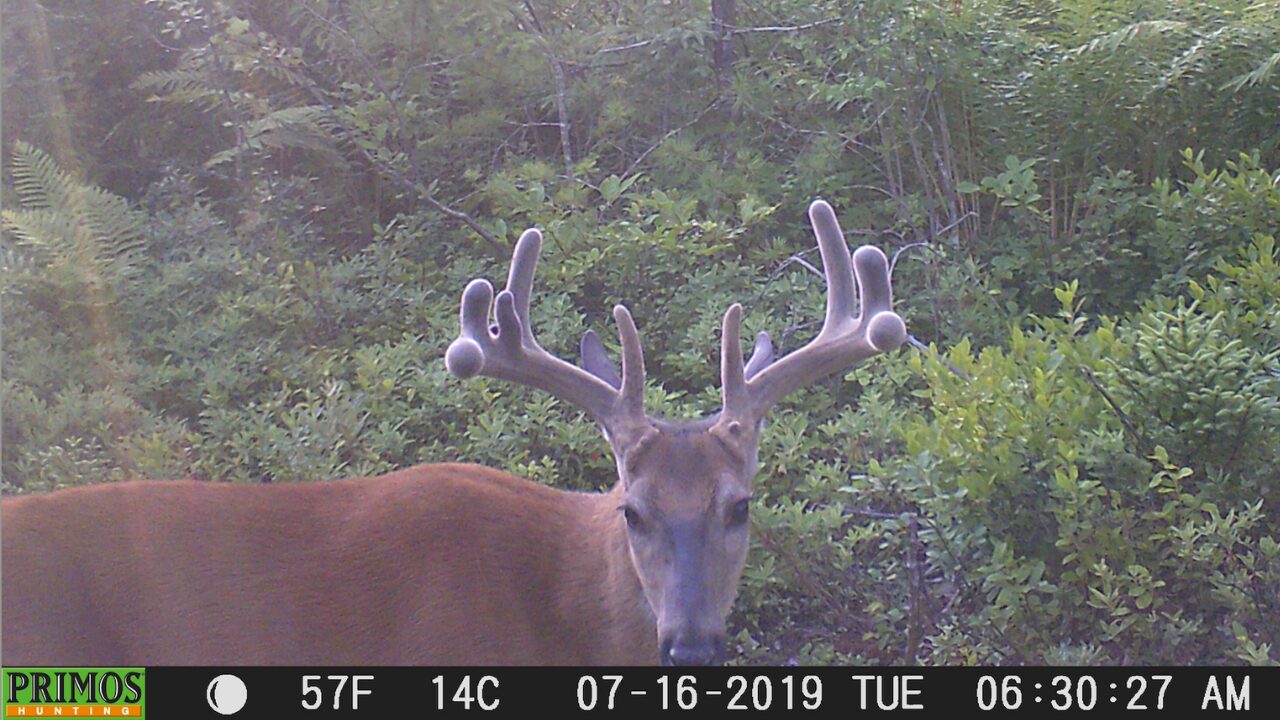Whitetail energetics shows us that whitetails are not simple-minded animals that aimlessly walk through the woods with no purpose. It’s quite the opposite. Their entire lives revolve around maximizing energy use for survival and reproduction. With this information, you can put the odds more in your favor by creating a strategy for each hunt that maximizes your success. Randomly meandering or sitting in the woods is a recipe for failure. In order to get the most out of a hunt, you need to think about what a big buck would want to do on that particular day. It could be to conserve the most energy or to have the most reproductive success, or a mix of both.
What Is Whitetail Energetics?
I define whitetail energetics by; a whitetail’s thought process on how to most efficiently acquire/expend its energy in order to maximize its survival and reproduction.
There are many similarities between big bucks, young bucks, and does in energetics, with the ultimate goal being the same; use energy as efficiently as possible to maximize survival/reproduction. However, between bucks and does one big difference; thought processes. Thought processes between genders are different to achieve this goal. However, for the purposes of this article, I will primarily be explaining how energetics directly influence the decisions of big bucks.
To explain the importance of whitetail energetics, consider this; energy is a whitetail’s form of currency. How so? Energy can be spent on survival and reproduction, and the more energy a particular buck has the more he can spend on those things. So, until the rut, bucks are focusing on one thing; acquiring and conserving energy.
Knowing this, wouldn’t it make sense to learn what decisions big bucks make in order to acquire and use energy most efficiently? By understanding whitetail energetics, you will be able to find big bucks more successfully. You will be more able to get into the mindset of the caliber animal you’re hunting and to be able to predict movements depending on the many factors that influence whitetail energetics.
Whitetail Energetics & Habitat Relationship
There is an energy flow between a whitetail and the habitat it has chosen to live in. Another way to look at it is the high-quality habitat has chosen the big buck to live in it. When you look at habitat this way, after a while you can start to pick up similarities between the highest-quality habitats and you can start scouting habitat instead of bucks. This is because big bucks will gravitate to the highest-quality habitat in order to maximize energy efficiency.
Whitetails are slaves to nature. They have to seek out high-quality habitat to sustain their energetic demands for survival and reproduction. Unlike people, deer cannot manipulate their habitat in order to increase survival. Also, people don’t worry about the energy we exert because we have so much food, water, and shelter available to us that we can replenish our energy at any time. Whitetails and other wildlife have to try to save and store energy at certain times of the year when food is abundant so it can be used when it is needed most.
Mature bucks are very patternable from year to year. Especially so during years when food sources and abundance remains similar. They have fine-tuned the most energetic way to survive from previous years. To deviate much from this would likely lead to unnecessary energy expenditure, reducing chances of reproduction and survival.
Although some areas may be good enough to support a whitetails life, they are still going to choose the highest quality habitat available to them in order to maximize their energetic gains. I can only think of a couple of reasons whitetails would choose to live in lower-quality habitat than what is available in the surrounding area. Reasons would include; too many deer in the high-quality habitat already and high hunting pressure/poor safety.
High-quality habitat will maximize energy gains. Energy gains are the life goal of big bucks until the rut rolls around and it switches to breeding. As a deer hunter high-quality habitat combined with energetics is important to understand because helps predict with a higher degree of accuracy where a big buck is likely located before the rut.
Science Behind Whitetail Energetics
Energy is the biggest factor influencing the success of a buck to breed and survive to pass on his genes, and bucks know it. The more energy a buck has, the more it can be used when it’s needed most. Having a surplus of energy at the right time of year gives certain bucks a competitive advantage over other bucks. So how does a whitetail acquire more energy? By using less than it burns.
To understand energetics, you should know what a Calorie is, simply put, it is a measurement of energy. There are three bodily functions that burn Calories in organisms;
- Basal Metabolic Rate (BMR)
- Thermal Effect of Food (TEF)
- Physical Activity (PA)
Total Daily Energy Expenditure (TDEE)
- BMR+ TEF+ PA = TDEE
BMR is the absolute minimum number of Calories (energy) an organism, such as a whitetail, needs to consume in order to maintain current body weight. TEF is the energy it takes to digest food. PA is the energy expended exerting any type of movement. When you add these three Calorie consuming bodily functions up, you get the total daily energy expenditure (TDEE). A whitetail that consumes and digests more calories than TDEE will gain weight and vice versa. In order to simplify this, take a look at this equation:
TDEE – Energy Consumed = Calories Gained or Lost
- TDEE > Energy Consumed = Lose Weight
- TDEE < Energy Consumed = Gain Weight
Body Fat, Energy, and Survival
When a deer consumes more energy than what its body needs (TDEE < Energy Consumed), it will be stored as body fat. Why does a deer want body fat? Because fat is stored energy that can be used when external sources of nutrition don’t provide enough Calories to exceed TDEE. When deer can’t eat enough Calories or are burning too many Calories from activity, then body fat will be burned instead. Essentially, it is backup energy.
Whitetails cannot control their BMR or TEF to a large degree, but they can reduce energy expenditure from these through rest and sleep. They can control their amount of physical activity to a much larger degree. Limiting physical activity, such as fighting is important for survival. The reason bucks will fight is that there is an opportunity for reproductive success. Often reproductive success outweighs the energy costs of fighting. In a fighting scenario, a win would energetically make sense because the buck would be able to pass on his genes. However, bucks take risks when they fight with each other. Not only will the loser spend a lot of energy that could be used for survival, but he will also not pass on his genes. Too much fighting will limit the energy bucks have for breeding.
Fat is essential for survival in the colder months for insulation and nutrition. Having body fat during the cold months means more backup energy for when weather conditions don’t allow deer to stay at or above TDEE. This is how deer are able to survive periods of harsh weather conditions. A deer that uses less energy will generally put on more fat because physical activity is lower, which conserves more Calories. This is why hunters often don’t see big bucks until the rut has started. Big bucks are resting and digesting all day until the rut so that way they can maximize their stored energy for reproductive success.
Body Fat, Energy, & The Rut
Having healthy stores of fat gained from the growing season allows bucks to focus on one thing, reproduction. Because bucks were putting on as much fat as they could during the growing season, they can afford to take a short break from focusing on energy accumulation. Instead, they will burn these energy reserves and put it towards reproductive success.
Because of the importance and short window of the breeding season, reproductive success is ranked higher than everything else in the mind of a buck. Essentially, this is what bucks have been preparing for since the growing season. Fat reserves allow for a higher competitive advantage over other bucks with less available body fat during the rut. The reason for this is the bucks with more body fat have more energy to use. The Quality Deer Management Association (QDMA) states “bucks can easily lose 20 to 25 percent of their body weight during the rut”. This goes to show you how important fat is to rutting bucks.
Weather & Whitetail Energetics
Snow, rain, wind, hot, and cold…etc all play a role in how whitetails move from day-to-day. Knowing that bucks are trying to use energy as efficiently as possible in order to maximize reproductive success during the rut you’ll need to ask yourself before every hunt: ‘what is a buck going to do today? Will he want to be on his feet? Or will he spend too much energy doing so based on the weather conditions so that it’s not worth his time or effort?’
Does it make sense to hunt from a treestand if there is a blizzard with 40 mph winds? What about in 70º F temps in November? No, deer are likely not moving because it’s too energetically expensive. They will be resting and digesting and wait a day or two for conditions to improve. Bucks will get the most out of their energy this way. Knowing this you could make a more aggressive game plan and increase your odds of success. Thinking about how weather affects energetics will help put the odds in your favor for success.
Whitetail Energetics & Hunting Pressure
Although understanding whitetail energetics is a fantastic tool in order to improve your hunting success, it’s important to understand that energetics is best understood if hunting pressure did not exist. This shows how whitetails would interact with nature under unpressured conditions. Under non-pressured situations, whitetail energetics is very accurate in predicting what deer are up to throughout the year.
It’s important to first understand how deer move in unpressured scenarios because it allows you to understand where deer want to be naturally. When pressured, these deer still want to be where they would be if unpressured. However, they know that it’s too risky. This causes them to avoid going to these areas or at least until they feel safe (like at night).
However, the truth of the matter is that you are probably dealing with a certain degree of hunting pressure. Once you understand how deer would react in unpressured scenarios you can start thinking about what the bucks might do under the specific amount of hunting pressure your area is receiving.
When hunting pressure is involved, energetics provides the framework for determining where deer will be. But survival is another large piece of the puzzle. Bucks especially will veer away from making the most energetically-sense decisions if there is a threat to their survival. This is because bucks bed for security and does bed for food. Because bucks are bedding for security they will go out of their way and spend more energy in order to get to places that make them feel safer. This may mean creating a nest in the middle of a swamp somewhere in a highly pressured area.
Conclusion
I hope you’ve taken away some insights that help you become a better deer hunter. Energetics is a large portion of the puzzle in finding big bucks. Knowing that a whitetail’s life revolves primarily around energy acquisition for reproduction and survival, you can more accurately predict what bucks are thinking throughout the year. This greatly improves your chances of taking a big buck.
That being said, does whitetail energetics predict the movement of all bucks 100% accurately? No. Information in this post is what I’ve found to be what the average big buck is thinking based on energetics at different times of the year. Bucks could be moving at any time, anywhere, for any number of reasons, and you could see success despite the information in this article. However, this article does help you put the odds in your favor for the most success. Most people can’t take the whole hunting season off from work, so knowing when to use your vacation time wisest based on energetics will put yourself in positions to have more consistent success in the woods.
Thinking in terms of energetics has helped me become much more successful for finding big bucks. I hope this article has helped you think about how you can put a big buck on the ground this fall. Let me know if you have any questions in the comments below, I will do my best to get back to you.
Looking For More Hunting Information? Find Me On:
By: Jason Tome




